- Home
- Blockchain
- Quadratic Voting in DAOs Explained: How It Prevents Whale Dominance
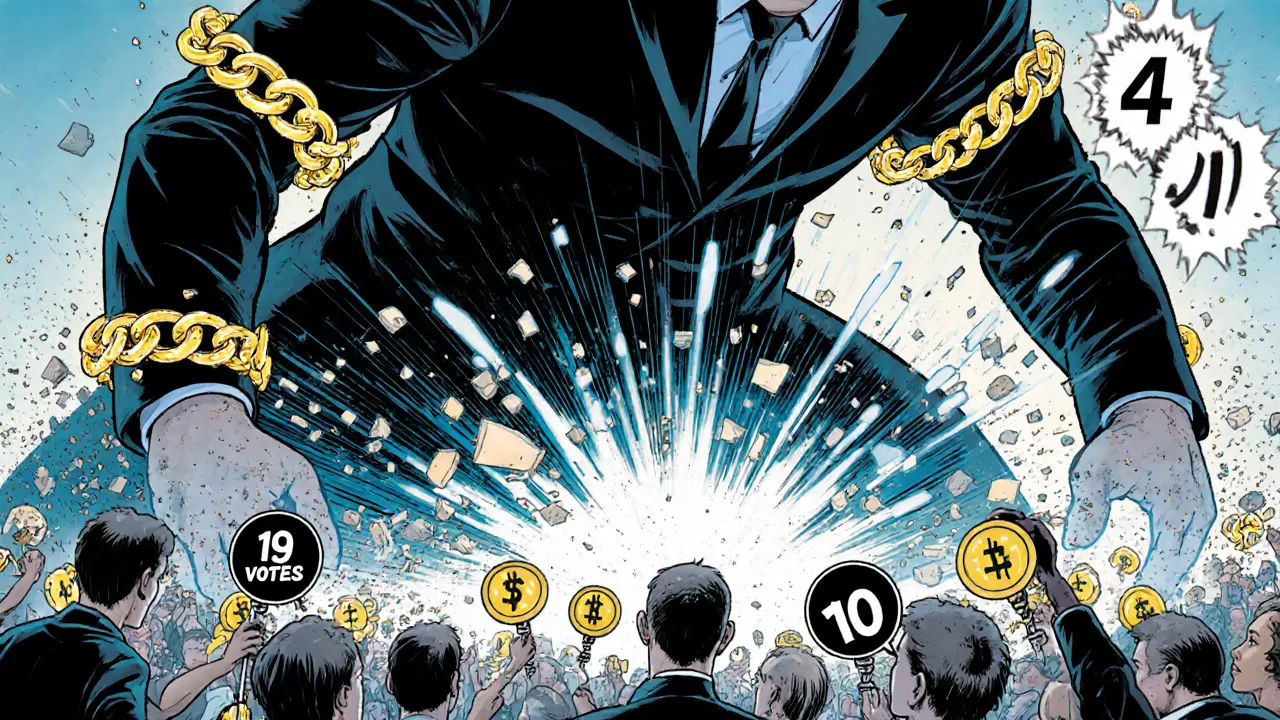
Quadratic Voting in DAOs Explained: How It Prevents Whale Dominance
Quadratic Voting Calculator
How Quadratic Voting Works
Quadratic voting makes it expensive to stack votes. Each vote costs more than the last, using a quadratic formula:
Cost = votes²
This means 1 vote = 1 token, 2 votes = 4 tokens, 3 votes = 9 tokens, and so on.
Calculate Your Voting Power
Results
Traditional Voting: 10 votes cost 10 tokens
Quadratic Voting: 10 votes cost 100 tokens
This makes it difficult for whales to dominate proposals while giving smaller holders more meaningful influence.
Imagine a DAO where one person holds 100 tokens and everyone else holds just 1 token each. In a normal vote, that one person controls 100 votes out of 199 total - nearly half the power. That’s not democracy. That’s plutocracy in disguise. This is why quadratic voting was invented: to stop whales from running the show.
How Quadratic Voting Works (No Math Degree Needed)
Quadratic voting isn’t about who has the most tokens. It’s about how much you care. In this system, each vote costs more than the last - not linearly, but quadratically. That means:- 1 vote = 1 token
- 2 votes = 4 tokens
- 3 votes = 9 tokens
- 10 votes = 100 tokens
The cost isn’t 10 times more for 10 votes - it’s 100 times more. That’s the square of the number of votes. So if you really care about a proposal, you can spend more. But if you try to buy 50 votes, it’ll cost you 2,500 tokens. Most people won’t - or can’t - do that.
This flips the script. Instead of letting a few big holders dictate outcomes, quadratic voting gives small stakeholders real influence. In a DAO with 99 members holding 1 token each and one whale holding 100 tokens:
- Linear voting: Whale has 100 votes, others have 99. Whale wins.
- Quadratic voting: Whale can cast only 10 votes (square root of 100). Others together can cast 99 votes. The group wins.
That’s not magic. It’s math designed to balance power.
Why Token-Weighted Voting Fails in DAOs
Most DAOs still use simple token-weighted voting. It’s easy to build. But it’s broken.Early DAOs assumed that holding more tokens meant you had more skin in the game - and therefore deserved more say. But that’s not how it plays out. Big holders often:
- Buy votes from smaller members
- Collude with other whales
- Ignore proposals that don’t benefit their portfolio
- Leave the DAO after voting, taking their power with them
Real-world examples show this clearly. In 2023, a major DAO voted to allocate funds to a project that only benefited three large holders. The rest of the community didn’t vote because they knew their 1-token votes wouldn’t matter. That’s not governance. That’s a rigged game.
Quadratic voting fixes this by making it expensive to stack votes. It doesn’t stop whales from participating - it just stops them from dominating.
Real-World Use Cases That Actually Worked
Quadratic voting isn’t just theory. It’s been tested.CityDAO used it to decide which land parcels to buy for a decentralized city. With 2,000+ members, they needed a way to avoid a few rich contributors buying up all the property. Quadratic voting let small holders express strong support for specific locations - and they won several bids.
Codeless Conduct, a hackathon DAO, used quadratic voting to judge submissions. Instead of letting sponsors pick winners, they let participants vote with their tokens. The result? A winning project chosen by 60% of voters - not the top token holder’s favorite.
Realms, a DAO platform, built a plug-in that automatically applies quadratic voting. It uses a credit system: each member gets a fixed number of voting credits per proposal. You can spend them on one issue or spread them out. The platform also integrates with Civic Pass to verify that each vote comes from a real person - not a bot or fake account.
These aren’t niche experiments. They’re working models for how DAOs can make real decisions without surrendering power to a few.
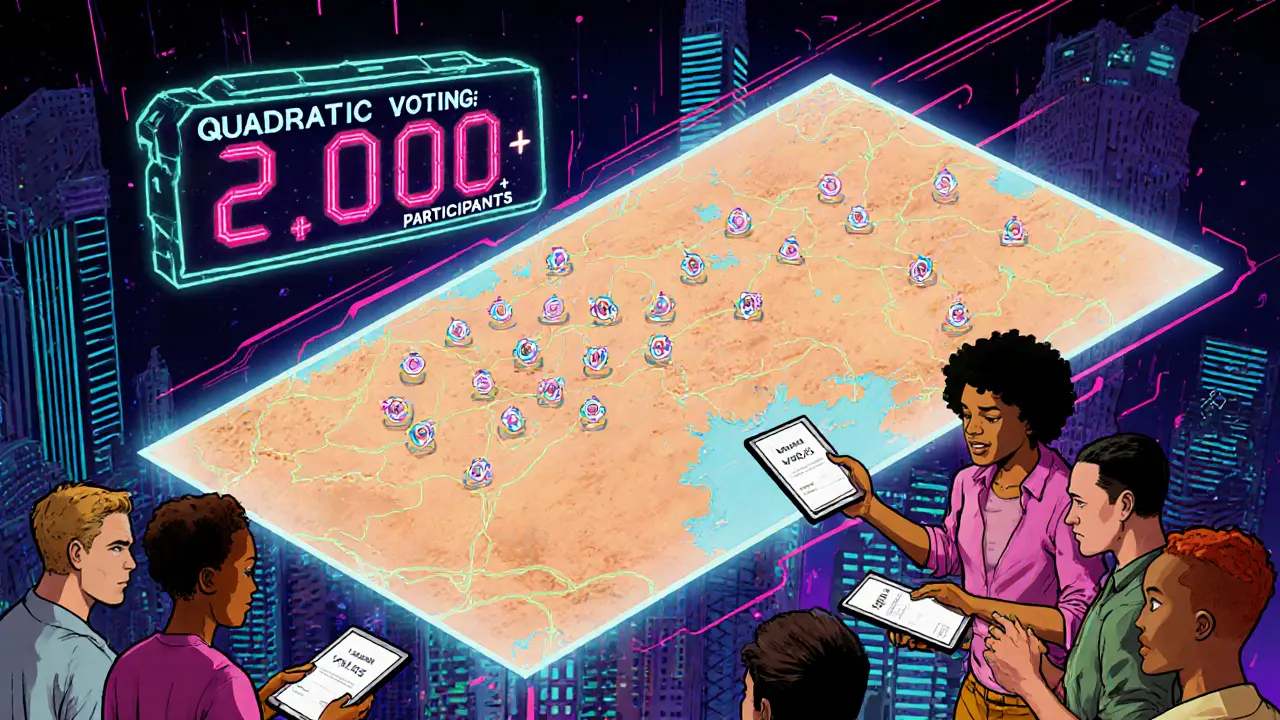
The Big Hurdles: Complexity and Sybil Attacks
Quadratic voting sounds great - until you try to use it.First, the math is confusing. Most people don’t understand why 3 votes cost 9 tokens. If you don’t explain it well, people either don’t vote or vote randomly. DAOs that skipped education saw participation drop by 40% in the first month.
Second, Sybil attacks are a real threat. A bad actor could create 100 fake accounts, each with 1 token, and cast 100 votes - 10 per account - for a total of 1,000 vote points. That’s more than a whale with 10,000 tokens.
That’s why identity verification matters. Realms and other platforms now require:
- Phone number verification
- Proof of human identity via Civic Pass or Worldcoin
- One account per person
Without this, quadratic voting becomes just another tool for manipulation.
Third, voters need a budget. If you give everyone unlimited tokens to vote with, the system breaks. Most DAOs now give members a fixed number of credits per proposal - say, 100 credits - to spend however they want. That forces people to prioritize. Do you spend 81 credits on one proposal? Or spread 10 credits across 10? That’s where real democracy happens.
Who Benefits Most From Quadratic Voting?
It’s not the whales. It’s the quiet majority.People who:
- Hold 1-5 tokens
- Are active in the community but not investors
- Want to shape the direction but don’t have money to buy more tokens
- Are tired of seeing proposals pass because one person owns 30% of the supply
These are the people who usually get ignored. Quadratic voting gives them a voice that scales with their passion - not their wallet.
Studies from Frontiers in Blockchain (2024) show that DAOs using quadratic voting see 3x higher participation from small holders. Proposals that benefit the broader community are 60% more likely to pass.
It’s not perfect. But it’s the only system that makes sense when you care about fairness, not just efficiency.
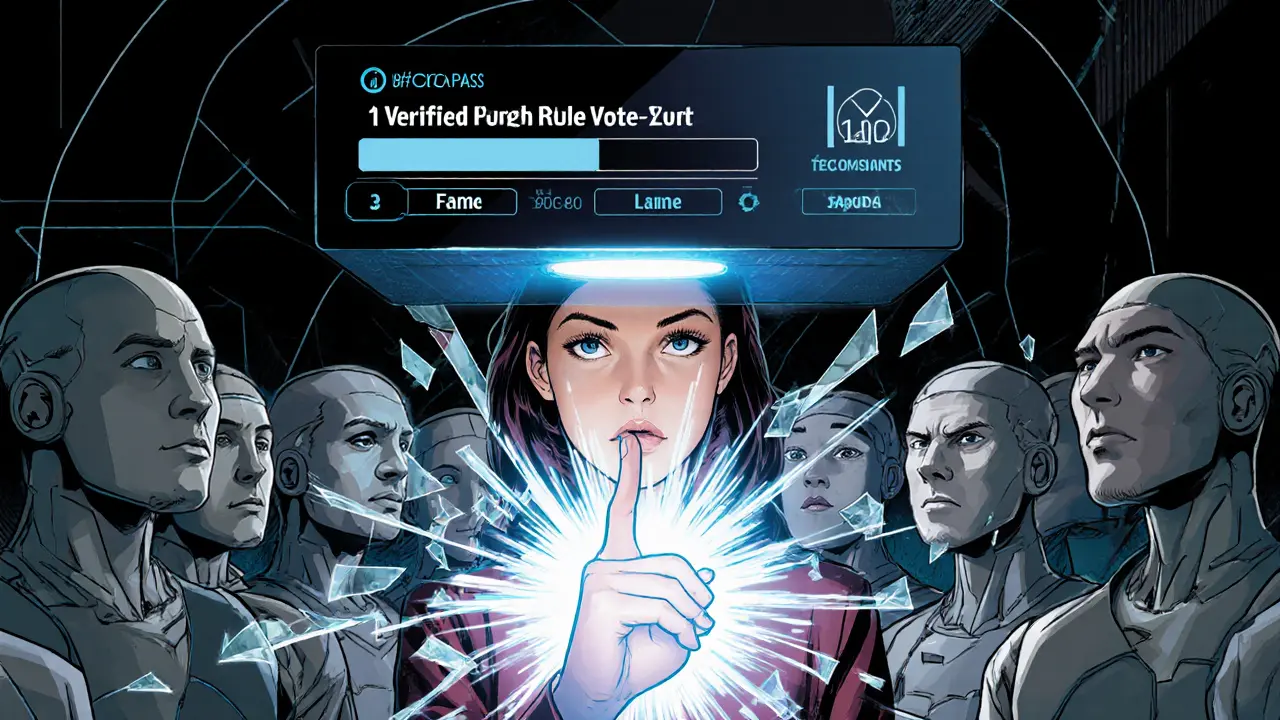
What’s Next for Quadratic Voting?
The tech is improving fast.In 2024, new tools like DAOstack and Snapshot+ started offering drag-and-drop quadratic voting interfaces. No more spreadsheets or calculators. You just slide a bar to pick how many votes you want - and the system auto-calculates the cost.
Some DAOs are now testing “dynamic credits”: your voting budget increases if you’ve participated in past votes. That rewards engagement, not just token ownership.
And researchers are exploring hybrid models - combining quadratic voting with conviction voting, where votes gain weight over time. That could make long-term commitment matter more than quick flips.
One thing’s clear: as DAOs grow and handle real money, real property, and real legal decisions, they can’t keep using 2020-era voting. The future belongs to systems that reflect true community will - not concentrated wealth.
Should Your DAO Use Quadratic Voting?
If you’re running a DAO and you’ve noticed:- Only 5-10 people vote on every proposal
- The same few addresses always win
- Small holders are disengaged
- Proposals favor whales, not the community
Then you need quadratic voting.
Start small. Pick one proposal to test it on. Use Realms or another platform with built-in support. Educate your members with a 5-minute explainer video. Give everyone the same voting credit budget. Watch what happens.
Don’t wait until you’re flooded with proposals and your community is burned out. Fix the system before it breaks.
Quadratic voting won’t solve everything. But it’s the most honest way we’ve found to let a decentralized group make decisions together - without letting the richest ones call all the shots.
What is quadratic voting in DAOs?
Quadratic voting is a governance system where the cost of casting multiple votes on a proposal increases quadratically. For example, 1 vote costs 1 token, 2 votes cost 4 tokens, 3 votes cost 9 tokens. This makes it expensive for large token holders to dominate decisions, giving smaller stakeholders more influence based on how strongly they feel about an issue.
How does quadratic voting stop whale dominance?
In traditional voting, a whale with 100 tokens gets 100 votes. In quadratic voting, that same whale can only cast 10 votes (the square root of 100). Meanwhile, 99 members with 1 token each can cast 99 votes together. This flips power from concentrated wealth to collective preference, ensuring the majority’s voice isn’t drowned out.
Is quadratic voting more democratic than token-weighted voting?
Yes. Token-weighted voting rewards wealth, not participation. Quadratic voting rewards intensity of preference. Research from Frontiers in Blockchain shows it better reflects the will of a larger number of participants, especially when Sybil attacks are prevented and voters are given equal credit budgets.
What are the biggest challenges of implementing quadratic voting?
The main challenges are voter confusion (the math isn’t intuitive), Sybil attacks (fake accounts), and low participation. Without identity verification (like Civic Pass) and clear education, people either don’t vote or vote randomly. DAOs must also set fair voting credit limits to prevent abuse.
Which DAOs are using quadratic voting successfully?
CityDAO used it to decide land purchases, letting small holders influence property bids. Codeless Conduct used it to judge hackathon entries fairly. Realms offers a plug-in that automates quadratic voting with built-in Sybil resistance. These are real, working examples - not just experiments.
Do I need to hold a lot of tokens to use quadratic voting?
No. In fact, quadratic voting is designed for people who hold few tokens. Your voting power comes from how many votes you want to cast on issues you care about - not how many tokens you own. You can have 1 token and still influence outcomes if you vote strategically.
Can quadratic voting be hacked or manipulated?
Yes - if Sybil attacks aren’t prevented. A bad actor could create hundreds of fake accounts to cast votes. That’s why successful implementations use identity verification like Civic Pass or Worldcoin to ensure each vote comes from a real person. Without this, quadratic voting becomes just another attack surface.
Is quadratic voting the future of DAO governance?
It’s one of the most promising paths. As DAOs handle more complex decisions - funding, legal structure, asset ownership - they need systems that balance efficiency with fairness. Quadratic voting does that better than any other mechanism tested so far. Adoption is still limited, but tools are improving fast. It’s likely to become standard in mature DAOs by 2027.
Cormac Riverton
I'm a blockchain analyst and private investor specializing in cryptocurrencies and equity markets. I research tokenomics, on-chain data, and market microstructure, and advise startups on exchange listings. I also write practical explainers and strategy notes for retail traders and fund teams. My work blends quantitative analysis with clear storytelling to make complex systems understandable.
Popular Articles
2 Comments
Write a comment Cancel reply
About
DEX Maniac is your hub for blockchain knowledge, cryptocurrencies, and global markets. Explore guides on crypto coins, DeFi, and decentralized exchanges with clear, actionable insights. Compare crypto exchanges, track airdrop opportunities, and follow timely market analysis across crypto and stocks. Stay informed with curated news, tools, and insights for smarter decisions.

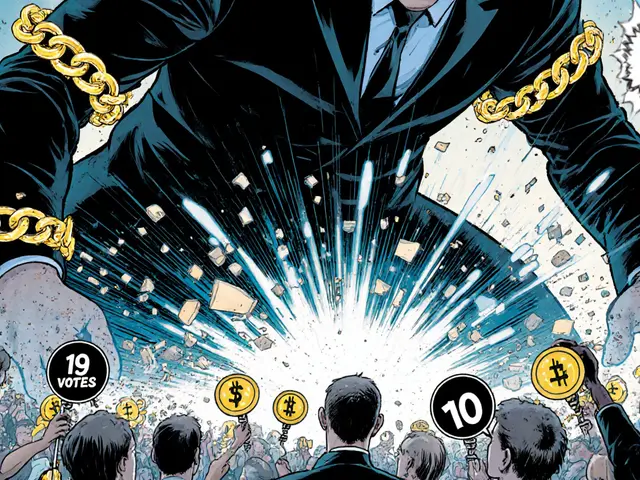
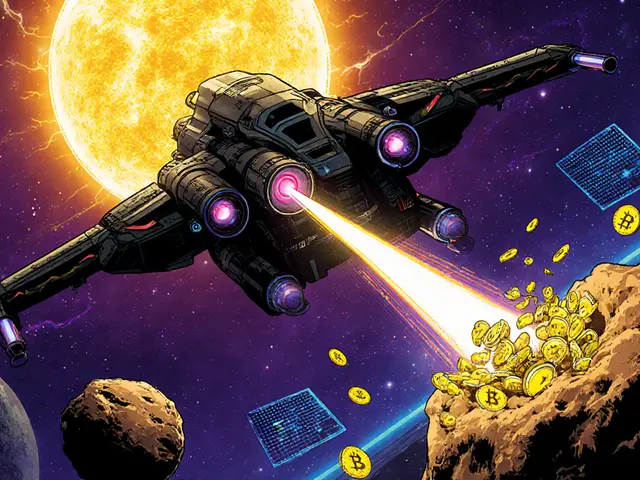

Bro this is just socialism with blockchain buzzwords. Next they’ll make us vote on how many crypto coins we can own. LOL.
This is actually one of the coolest ideas I’ve seen in DAOs lately. I used to think token voting was fine until I saw how 3 guys owned 70% of the votes in my old DAO. Quadratic voting? It’s like giving the quiet people a megaphone instead of just letting the loudest guy scream over everyone. Real change.